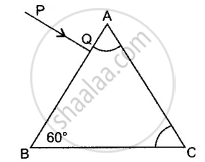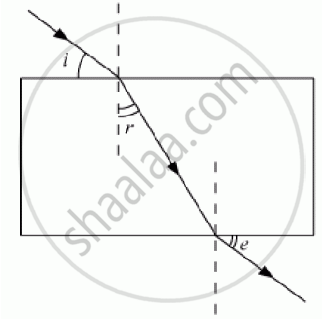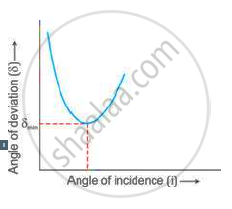Advertisements
Advertisements
प्रश्न
In the diagram alongside a ray of light, PQ is incident normally on one face AB of an equilateral glass prism. What is the angle of incidence at the faces AB and AC?

उत्तर
∠ of incidence of face AB = 60°
∠ of incidence of face AC = 60°
APPEARS IN
संबंधित प्रश्न
Write a short note on dispersion of light.
How is the refractive index of a medium related to the speed of light in it?
When light travels from a rarer to a denser medium, its speed ______.
How does the angle of deviation produced by a prism change with increase in the angle of incidence. Draw a curve showing the variation in the angle of deviation with the angle of incidence at a prism surface.
A student traces the path of a ray of white light through a rectangular glass slab and marks, the angles of incidence (∠i) , refraction (∠r) and emergence (∠e) as shown. Which angle or angles has he not marked correctly?

(A) ∠i only
(B) ∠i and ∠r
(C) ∠i and ∠e
(D) ∠r and ∠e
Using the curve, how do you infer that for given prism, the angle of minimum deviation δmin is unique for the given light?

Does the depth of a tank of water appear to change or remain the same when viewed normally from above?
A ray of monochromatic light is incident from the air on a glass slab:
(i) Draw a labelled ray diagram showing the change in the path of the ray till it emerges from the glass slab.
(ii) Name the two rays that are parallel to each other.
(iii) Mark the lateral displacement in your diagram.
The diagram below shows two parallel rays A (Orange) & B (Blue) incident from air, on air-glass boundary.

- Copy and complete the path of the rays A and B.
- How do the speeds of these rays differ in glass?
- Are the two refracted rays in glass parallel? Give a reason.
